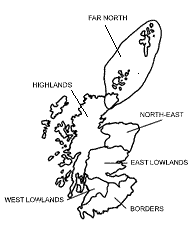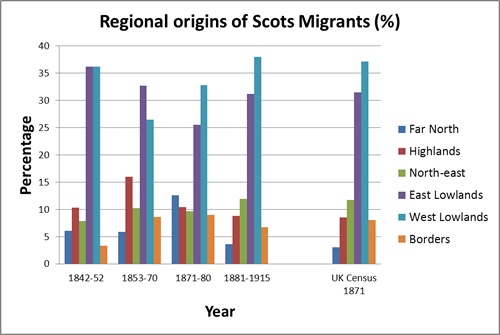 | 1842 –52 | 1853 –70 | 1871 –80 | 1881 –1915 | UK Census 1871 | |
|---|---|---|---|---|---|---|
| Far North | 6.1% | 5.9% | 12.6% | 3.6% | 3.1% | |
| Highlands | 10.3% | 16% | 10.4% | 8.8% | 8.5% | |
| North-east | 7.9% | 10.2% | 9.7% | 11.9% | 11.7% | |
| East Lowlands | 36.2% | 32.7% | 25.5% | 31.2% | 31.5% | |
| West Lowlands | 36.2% | 26.5% | 32.8% | 38% | 37.1% | |
| Borders | 3.3% | 8.6% | 9% | 6.7% | 8.1% |
The table and graph suggest:
- In terms of regional origins the migrants from Scotland to New Zealand were a very balanced cross-section of the Scots as a whole. There were few marked regional concentrations.
- Since the vast majority of the Scottish population lived in the lowlands, it is not surprising that this area was the origin of about 60% of New Zealand's Scots immigrants. The only change was a slight shift from the East Lowlands around Edinburgh to the West Lowlands around Glasgow. This may reflect in the early years the influence of Edinburgh leaders in the Otago settlement and the importance of Glasgow as a port of departure in the later years.
- There was a strong representation from the far north of Scotland especially the off-shore islands. Indeed Shetland Islanders comprised 13.8% of the Scots miners going to the West Coast and 6.2% of those going to the Otago diggings and a high proportion of all assisted Scots during the 1870s. This probably followed an article in the Shetland Advertiser in 1862 on the Otago gold discoveries, and initiated a strong and distinctive flow to New Zealand from Shetland.
- People from the Highlands were also well-represented among the mining community (18.4% of Scots miners), but, contrary to tradition, they were only marginally over-represented among the other immigrant flows.
- The Borders and the North-east tended to be slightly under-represented.

